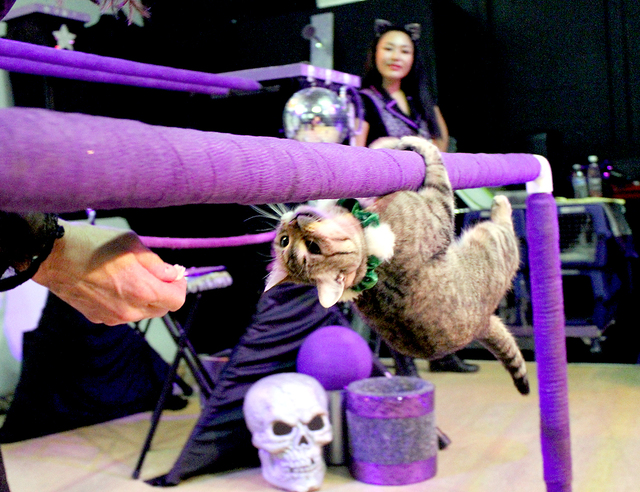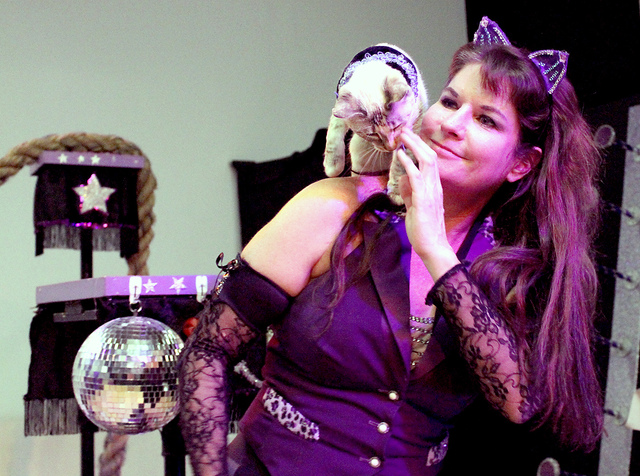Feline divas, dependable chicken star when the cat circus comes to town
By Kate Santich
ADVERTISING
Orlando Sentinel
ORLANDO — Sure, dogs have been known to sniff out terrorists, rescue avalanche victims and guide the blind.
But can they play the drums?
Samantha Martin’s cats can. They also can play a keyboard and guitar — though, to be fair, the guitar performance more closely resembles scratching than playing.
“All original material,” Martin says, straight-faced.
Martin is “chief executive human” for The Acro Cats — a circus troupe of 14 felines currently doing a 10-day stint at The Venue in Orlando. In the course of an hourlong show, you’ll see cats riding skateboards, walking tightropes, climbing ropes, leaping tall perches and balancing atop rolling cylinders. The Rock Cats play for the finale.
Or, at least, that’s the plan.
“The cats really decide the show,” says Martin, who travels cross-country with her troupe.
The troupe rolled into town recently well before dawn in a colorful 1963 passenger bus, retrofitted for the comfort of the cats, and a van with a giant fiberglass cat figure on top. The show includes Martin and two additional humans — all sporting cat ears and various catlike attire — and one groundhog, three rats and a chicken.
“The chicken is the most professional member of the troupe,” Martin says. “If the whole show falls apart because nobody wants to do what they’re supposed to do for whatever reason, I can always count on the chicken to come through for me.”
Chickens, it seems, have remarkably singular focus. Cats? Not so much.
“Who knew that our cat Wiki does not like women with big white hairdos until one sat in the front row?” Martin says. “And then Wiki would not come out from under the table. He was just frozen, staring at this woman with big white hair.”
The cats are all orphans, rescues and strays that have become Martin’s pets, distinguishing her act, she says, from the handful of other cat circuses around the nation. But there is also a large dose of spontaneity. Typically, one or two performers will skitter offstage and into the crowd mid-performance, rubbing themselves against audience members’ legs and walking nonchalantly across their laps.
“You just go with it,” Martin says. “The cats always come back, and eventually they’ll do their trick — usually when something else is supposed to be going on. It’s why people come back again and again. They want to see what the cats will do this time.”
They also come — as Orlando’s Margo Dixon did on opening night — because they are devout cat lovers looking for redemption.
“Most people think it’s just dogs that do these kinds of things,” Dixon says. “They don’t realize that cats can be trained like this too. It is very cool.”
The message is one that Martin hopes to spread. More cat training, she says, will improve the cat-owner bond and lead to fewer cats being abandoned. In fact, she says, cats have enormous capacity to follow directions.
“You just have to have the right incentive,” she says. “Dogs will work for love. They’re really not good negotiators. Whereas cats are like, ‘Hmmmm. What’s in it for me?’”
Her better-known colleagues agree. Joel Slaven, founder of Joel Slaven’s Professional Animals, producer of the “Pets Ahoy!” show at SeaWorld,” says trainability is individual.
“You have to have the right cat — a cat that enjoys being the center of attention,” he says. “And then they have to be very comfortable and relaxed. You have to have a nice cattery for them to live in — a place where they can climb and relax and not be stressed — so that they have fun when they’re on stage.”
The best way to coax a cat to perform, he says, is to watch how it plays on its own and then reinforce that behavior. If you have a cat that likes to leap and climb, you simply praise and reward the leaping and climbing.
Martin has been studying these patterns since she was 10 and decided to train the family dog. Next came rats and then more exotic species — groundhogs, armadillos and, she swears, spiders.
“If it eats, if it has a brain, you can train it,” she says. In the Chicago neighborhood she still calls home, she ran a small educational zoo that worked with schools and libraries to teach children about animals.
But 12 years ago, after a neighbor asked her to cat-sit — then left for Poland, never to return — Martin’s focus narrowed.
“This cat ended up being pregnant, and she gave birth to all these little white kittens,” Martin says. “I ended up keeping one of them. She was just very special. She was very independent, but smart, and she just took to the training very, very quickly.”
Today that cat — Tuna — is the grand dame of the show, though she has become increasingly cranky in her senior years.
“She has cat-ta-tude,” says Seunga Park, a cat-wrangler and assistant. “If you try to pet her, she will slap you.”
Martin nods knowingly. “Tuna’s a diva,” she says. “She has been in a Petco commercial and an independent film. But she’s still waiting to hit the big time.”




